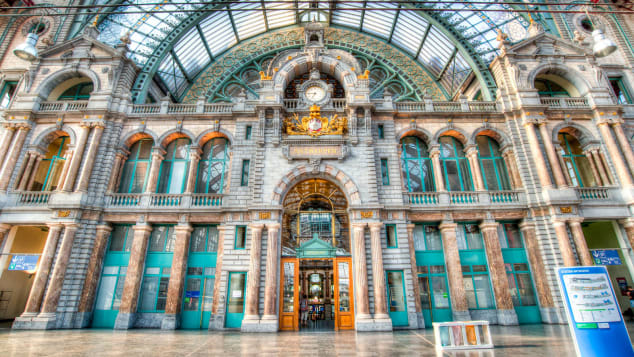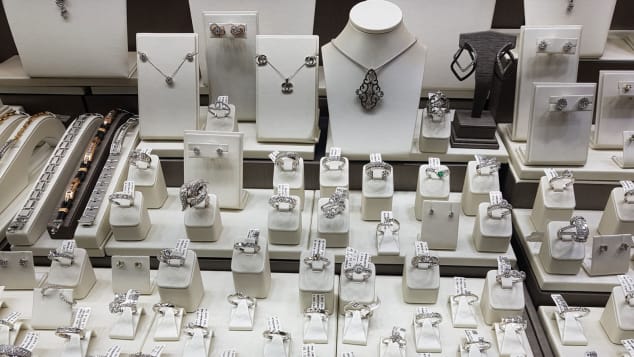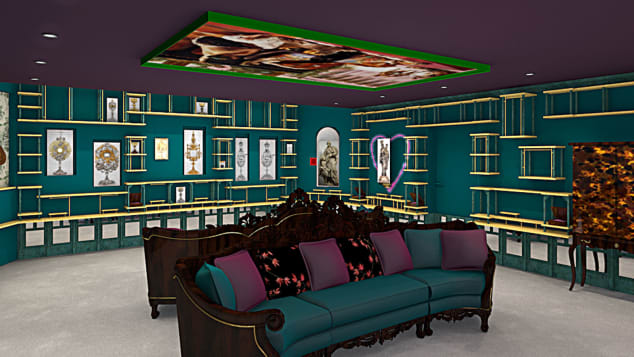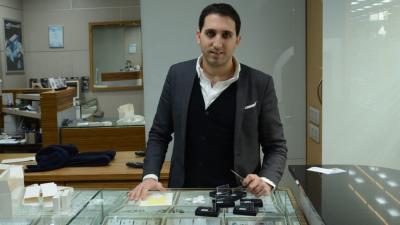
On the gemstone trail: A tour of Antwerp's diamond district
U bent hier
Bron: CNN - Diamond Blue - Oriane - Antwerp
(CNN) — With its flat-fronted 1960s buildings and plain color scheme, Hoveniersstraat might be dismissed as one of the most drab streets in the pretty baroque Belgian city of Antwerp.
In fact, it's one of the most fascinating, and there are several high security clues that give the game away.
The street is protected by a police station, dozens of CCTV cameras and several armed soldiers.
The reason: Hoveniersstraat is the center of Antwerp's -- and the world's -- diamond industry.
About 84% of all rough diamonds and 50% of all cut diamonds on the planet are traded in this destination today.
Located less than an hour from Brussels by train, the Belgian city, has been a major diamond center since medieval times.
"Antwerp has been a diamond centre for centuries," says Anne Claesen, who works as a guide on Antwerp's diamond walking trail. "The world's first stock exchange was founded here, trading everything from copper and silver to diamonds and gold."
I meet Claesen by Antwerp's train station, a vast terminus with elaborate neo-baroque decorations.
Claesen was part of a team of archivists who unearthed a document dated September 15, 1447 that established the city's reputation as a trusted hub for jewel trading.
The document carries a proclamation from the city's bailiff, mayor and aldermen declaring that "no one within the city of Antwerp is to buy, sell, pawn or pass on any false stones imitating diamonds, rubies, emeralds and sapphires..."
A new life
Antwerp's diamond district is located next to the main train station in the Belgian city.
Essential to this trade has been the city's Jewish population, many of whom fled to Antwerp from across Europe.
"The medieval authorities welcomed persecuted Jews who were expert diamond traders, having traveled long distances carrying their fortune in a portable pouch of precious stones," Claesen explains.
It was thus that Antwerp's Jewish population flourished and expanded.
At the turn of the last century, many Jewish families passed through the port of Antwerp as they fled rising anti-semitism and set sail via the ships of the famous Red Star Line for a new life in America.
Many stayed, however, and thus the area below the train station where they arrived, became the Jewish quarter, today's Diamond District.
Nearly two thirds of Antwerp's Jewish population was exterminated in World War II, but the city adopted special measures to attract those who fled after the conflict.
Beginning our tour, we following the railway tracks south, passing rows of shop windows displaying diamond jewelry until we reach Hoveniersstraat.
Claesen introduces me to Pieter Bombeke, a diamond polisher, whose atelier "Design For Diamonds" is one of 1,700 officially registered diamond enterprises in Antwerp's own Square Mile.
"In the 1950s-1960s there were about 40,000 polishers," he says, "but now only around 500 are registered and only 250-odd are active.
"Technology took over, as well as competition -- mostly from India, but also from China, Russia and Israel; however, the big stones are still cut here in Antwerp."
High security
One such "stone" was the Lesotho Promise, a 603-carat rough diamond, the largest find of the 21st century: it was sold in Antwerp and cut into 26 stones fashioned into a necklace, now on sale at Graff's in London.
Hoveniersstraat also houses the world's only rough diamond bourse.
Security is even tighter here. In order to visit, I have submitted my name and passport details in advance to Nathalie Linotte from the Antwerp World Diamond Center -- a body that promotes the industry in Belgium and abroad.
I leave my passport and camera by the door, pass through a metal scanner and enter the bourse floor.
I then sit in one of several caféteria-style tables. These are oriented perpendicular to the north-facing large windows as the subdued northern sunlight is the best light to examine diamonds under.
The floor is remarkably quiet, probably because most trading nowadays is done via computers or in private offices above the bourse.
Its Jewish roots are still conspicuous -- the bourse observes Jewish holidays, and a deal is sealed on a handshake saying "Mazal u'bracha," Yiddish for "Good fortune and blessing."
Linotte is at pains to explain how the diamond industry has responded to international outcry after the film "Blood Diamond" spotlighted its smuggling underside. Now the provenance for every diamond is guaranteed through the Kimberley Process certification scheme.
The certification process succeeded in diminishing the share of conflict or "blood" diamonds in the global trade from 15% to 0.2% since 2003.
Reputable retail outlets are also provided with an "Antwerp Most Brilliant" (AMB) designation; they must pass 30 stringent tests before they are awarded the badge.
Linotte takes me to the HRD lab, Europe's leading authority in diamond certification, where diamonds are graded for the four Cs: Carat (weight), Color (thirteen shades from pure white to tinted yellow), Clarity (ten degrees of purity) and Cut (four grades from Excellent to Fair).
"Lab workers who assess the color of diamonds can only work for half an hour a day and are not allowed to drink gin because it 'yellows' their sight," she says.
Stories behind the jewels
"Anyone can bring their grandmother's diamonds to the lab for assessment at a price that varies between $87 and $372 depending on the stones.
"Prices for diamonds rise exponentially by weight so my advice is to buy just under a carat for jewelry and just over a carat for investment".
May 2018 saw the opening of a new diamond museum, called DIVA, in the center of Antwerp.
Before its launch, curator Romy Cockx gave me a tour of the museum, which tells the stories behind the city's jewel industry.
Its first room discusses the history of the luxury trade in Antwerp and the culture of collecting rare objects, while the second is about diamond processing, with short films on how a diamond is cut and a ring is designed.
"You should allow one to two hours for your visit," says Cockx. "But you can easily spend a day playing and watching all the movies."
Room three explores the diamond trade, with a large globe showing how diamonds arrive in Antwerp from all over the world.
Seven short films discuss real life people from the 15th century onwards, with exhibits linked to the stories highlighted when the movies stop.
Room four showcases the museum's silverware collection. It's set out as a luxurious dining room in which guests can play interactive games, learn about real and fake diamond certificates and listen to diamond heist tales in the next room, which is designed as a vault.
The final room is a boudoir focusing on "diamond divas" such as Queen Victoria and Marilyn Monroe. There are displays of precious jewelry worn by trendsetters.
Diamonds and chocolate
You can take a quiz that determines what kind of a diva you'd be; afterwards a computer takes your picture, Photoshops it on the cover of a magazine with the appropriate jewelry, and emails you the result.
Outside the DIVA museum I spot a mezuzah (a Jewish decorative case containing a prayer scroll) by the door of a diamond shop.
Owner Tomer Reuveni comes from a diamond trading Jewish family and has been in the business since he was 19, a rarity nowadays with Jewish involvement in the city's diamond industry in decline.
He offers me a chocolate and tells me that his two shops -- Oriane and Diamond Blue -- are the only Jewish-owned AMB-certified outlets.
"Ours are the only shops where you can find diamonds, Jews and chocolates, everything that represents Antwerp," he jokes.
"Come in, if only to buy a souvenir diamond. The idea is to give everyone the opportunity to go home with one; the minimum purchase is as little as $48 for a polished diamond and
$36 for a rough one."
That's a very good price for a gift that lasts forever...
John Malathronas is a London-based travel writer and photographer. He has written or co-written 15 books, including the Rough Guide to Greece.




